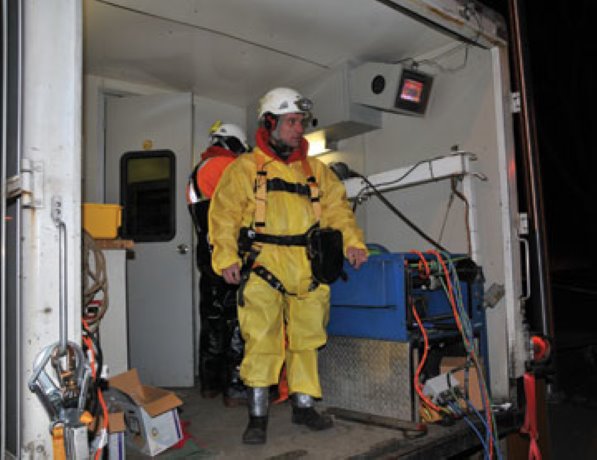The typical Canadian sewer line runs no deeper than about four metres below the surface. A 270-metre length of sewer line running north from the intersection of Locke Street and York Boulevard in Hamilton lies more than 25 metres below the surface — and it needed repair.
The typical Canadian sewer line runs no deeper than about four metres below the surface. A 270-metre length of sewer line running north from the intersection of Locke Street and York Boulevard in Hamilton lies more than 25 metres below the surface — and it needed repair.
“Everything in the system runs on gravity to achieve flow, so the line winds up that deep in order to maintain the grade,” says Kevin Bainbridge, Senior Project Manager of Infrastructure Programming, Public Works, with the City of Hamilton.
“The pipe was installed in 1960 as part of the Western Sanitary Sewer Interceptor using a manually-operated boring machine to dig the tunnel, and poured-in-place concrete — effectively the pipe was constructed inside the tunnel.”
The volume of concrete used in the pipe is high, with a diameter of approximately 1500 mm with 375-mm thick walls. Inspections undertaken in 1999 revealed cracking in the walls of the pipe.
“In the 1960s there wasn’t a lot of understanding of the way concrete set and we believe the cracking was the result of the curing process,” says Bainbridge.
“What came out of the inspection was our belief that there was potential for having fine ground material infiltrate through the cracks and creating cavities around the pipe that would cause structural failure of the pipe over time.”
Video inspections undertaken by PipeFlo Contracting Corp. of Hamilton and CRA Consultants in 2006 revealed that the cracking hadn’t gotten any worse since the original inspection.
PipeFlo and R.V. Anderson Associates Ltd. were then contracted to develop a plan of attack to see what could be done to rehabilitate the line.
That also allowed PipeFlo to test and verify the entry procedures for operating at the standpoint.
“The timing of the job depends on the sewer usage at any time, so went in at night when there’s a lot less flow and people aren’t using the toilet and the laundry and showering,” says Bainbridge.
A diversion tank constructed about 10 years ago to handle storm water would be used to contain the sewage flow to provide a window of operation for the contractors.
“We were willing to divert the flow to the point that we used 25 per cent of the tank’s capacity,” says Bainbridge.
Three PipeFlo crew members entered the pipe on the night of Feb. 23, with one stationed in the shaft and two going part way into the pipe and sending inspection equipment ahead. A surface unit maintained constant voice contact with the underground crew.
During a dry run, PipeFlo sent two different ground-penetrating radar (GPR) units about 10 metres into the pipe to determine which would be most suitable for the next entry.
“At the time the line was built, they didn’t keep such careful records of the construction methods and materials they used, says Bruce Noble, president of PipeFlo.
“We weren’t sure what the consistency of the concrete would be, or whether there was rebar in the pipe.”
The tank diversion also proved a success.
“At the end of the test run, the tank was only filled to six or seven per cent of its volume,” says Bainbridge. “So we were comfortable that we had a margin of error that would allow a full 12-hour shift.”
The pipe was then examined for debris, which was to be flushed out using a special cleaning nozzle. On next entry, the GPR device was to be used to ensure that no voids existed beyond the pipe walls.
“This is a high-risk environment, and putting people in pipes like this is the last thing we prefer to do,” Bainbridge said.
“In this case, it was determined that sending people down was the only way to examine and deal with the problem.
He said manual repair of the cracks during a 12-hour shift looked like the likely plan.












Recent Comments
comments for this post are closed